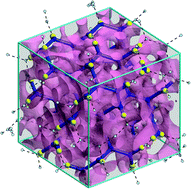当前位置:
X-MOL 学术
›
Soft Matter
›
论文详情
Our official English website, www.x-mol.net, welcomes your feedback! (Note: you will need to create a separate account there.)
Anatomy of triply-periodic network assemblies: characterizing skeletal and inter-domain surface geometry of block copolymer gyroids†
Soft Matter ( IF 2.9 ) Pub Date : 2018-04-23 00:00:00 , DOI: 10.1039/c8sm00078f Ishan Prasad,Hiroshi Jinnai,Rong-Ming Ho,Edwin L. Thomas,Gregory M. Grason
Soft Matter ( IF 2.9 ) Pub Date : 2018-04-23 00:00:00 , DOI: 10.1039/c8sm00078f Ishan Prasad,Hiroshi Jinnai,Rong-Ming Ho,Edwin L. Thomas,Gregory M. Grason

|
Triply-periodic networks (TPNs), like the well-known gyroid and diamond network phases, abound in soft matter assemblies, from block copolymers (BCPs), lyotropic liquid crystals and surfactants to functional architectures in biology. While TPNs are, in reality, volume-filling patterns of spatially-varying molecular composition, physical and structural models most often reduce their structure to lower-dimensional geometric objects: the 2D interfaces between chemical domains; and the 1D skeletons that thread through inter-connected, tubular domains. These lower-dimensional structures provide a useful basis of comparison to idealized geometries based on triply-periodic minimal, or constant-mean curvature surfaces, and shed important light on the spatially heterogeneous packing of molecular constituents that form the networks. Here, we propose a simple, efficient and flexible method to extract a 1D skeleton from 3D volume composition data of self-assembled networks. We apply this method to both self-consistent field theory predictions as well as experimental electron microtomography reconstructions of the double-gyroid phase of an ABA triblock copolymer. We further demonstrate how the analysis of 1D skeleton, 2D inter-domain surfaces, and combinations therefore, provide physical and structural insight into TPNs, across multiple length scales. Specifically, we propose and compare simple measures of network chirality as well as domain thickness, and analyze their spatial and statistical distributions in both ideal (theoretical) and non-ideal (experimental) double gyroid assemblies.
中文翻译:

三周期网络组件的解剖:表征嵌段共聚物回旋骨架的骨架和域间表面几何形状†
从嵌段共聚物(BCP),溶致液晶和表面活性剂到生物学的功能结构,三重周期网络(TPN)就像众所周知的gyroid和Diamond网络相一样,存在于软物质组装中。虽然TPN实际上是空间上变化的分子组成的体积填充模式,但物理和结构模型最常将其结构简化为低维几何对象:化学域之间的2D界面;一维骨架穿过相互连接的管状区域。这些较低维的结构为与基于三周期最小或恒定均值曲率表面的理想几何形状进行比较提供了有用的基础,并为形成网络的分子成分的空间异质堆积提供了重要的启示。这里,我们提出一种简单,有效和灵活的方法,从自组装网络的3D体成分数据中提取1D骨架。我们将这种方法既用于自洽场理论预测,又用于ABA三嵌段共聚物的双螺旋形相的实验电子显微照相重建。我们进一步演示了如何对一维骨架,二维域间表面及其组合进行分析,从而跨多个长度尺度提供TPN的物理和结构洞察力。具体来说,我们提出并比较了网络手征性和域厚度的简单度量,并分析了它们在理想(理论)和非理想(实验)双螺线管组件中的空间和统计分布。从自组装网络的3D体成分数据中提取1D骨架的有效而灵活的方法。我们将这种方法既用于自洽场理论预测,又用于ABA三嵌段共聚物的双螺旋形相的实验电子显微照相重建。我们进一步演示了如何对一维骨架,二维域间表面及其组合进行分析,从而跨多个长度尺度提供TPN的物理和结构洞察力。具体来说,我们提出并比较了网络手征性和域厚度的简单度量,并分析了它们在理想(理论)和非理想(实验)双螺线管组件中的空间和统计分布。从自组装网络的3D体成分数据中提取1D骨架的有效而灵活的方法。我们将这种方法既用于自洽场理论预测,又用于ABA三嵌段共聚物的双螺旋形相的实验电子显微照相重建。我们进一步演示了如何对一维骨架,二维域间表面及其组合进行分析,从而跨多个长度尺度提供TPN的物理和结构洞察力。具体来说,我们提出并比较了网络手征性和域厚度的简单度量,并分析了它们在理想(理论)和非理想(实验)双螺线管组件中的空间和统计分布。我们将这种方法既用于自洽场理论预测,又用于ABA三嵌段共聚物的双螺旋形相的实验电子显微照相重建。我们进一步演示了如何对一维骨架,二维域间表面及其组合进行分析,从而跨多个长度尺度提供TPN的物理和结构洞察力。具体来说,我们提出并比较了网络手征性和域厚度的简单度量,并分析了它们在理想(理论)和非理想(实验)双螺线管组件中的空间和统计分布。我们将这种方法既用于自洽场理论预测,又用于ABA三嵌段共聚物的双螺旋形相的实验电子显微照相重建。我们进一步演示了如何对一维骨架,二维域间表面及其组合进行分析,从而跨多个长度尺度提供TPN的物理和结构洞察力。具体来说,我们提出并比较了网络手征性和域厚度的简单度量,并分析了它们在理想(理论)和非理想(实验)双螺线管组件中的空间和统计分布。提供跨多个长度尺度的TPN的物理和结构洞察力。具体来说,我们提出并比较了网络手征性和域厚度的简单度量,并分析了它们在理想(理论)和非理想(实验)双螺线管组件中的空间和统计分布。提供跨多个长度尺度的TPN的物理和结构洞察力。具体来说,我们提出并比较了网络手征性和域厚度的简单度量,并分析了它们在理想(理论)和非理想(实验)双螺线管组件中的空间和统计分布。
更新日期:2018-04-23
中文翻译:

三周期网络组件的解剖:表征嵌段共聚物回旋骨架的骨架和域间表面几何形状†
从嵌段共聚物(BCP),溶致液晶和表面活性剂到生物学的功能结构,三重周期网络(TPN)就像众所周知的gyroid和Diamond网络相一样,存在于软物质组装中。虽然TPN实际上是空间上变化的分子组成的体积填充模式,但物理和结构模型最常将其结构简化为低维几何对象:化学域之间的2D界面;一维骨架穿过相互连接的管状区域。这些较低维的结构为与基于三周期最小或恒定均值曲率表面的理想几何形状进行比较提供了有用的基础,并为形成网络的分子成分的空间异质堆积提供了重要的启示。这里,我们提出一种简单,有效和灵活的方法,从自组装网络的3D体成分数据中提取1D骨架。我们将这种方法既用于自洽场理论预测,又用于ABA三嵌段共聚物的双螺旋形相的实验电子显微照相重建。我们进一步演示了如何对一维骨架,二维域间表面及其组合进行分析,从而跨多个长度尺度提供TPN的物理和结构洞察力。具体来说,我们提出并比较了网络手征性和域厚度的简单度量,并分析了它们在理想(理论)和非理想(实验)双螺线管组件中的空间和统计分布。从自组装网络的3D体成分数据中提取1D骨架的有效而灵活的方法。我们将这种方法既用于自洽场理论预测,又用于ABA三嵌段共聚物的双螺旋形相的实验电子显微照相重建。我们进一步演示了如何对一维骨架,二维域间表面及其组合进行分析,从而跨多个长度尺度提供TPN的物理和结构洞察力。具体来说,我们提出并比较了网络手征性和域厚度的简单度量,并分析了它们在理想(理论)和非理想(实验)双螺线管组件中的空间和统计分布。从自组装网络的3D体成分数据中提取1D骨架的有效而灵活的方法。我们将这种方法既用于自洽场理论预测,又用于ABA三嵌段共聚物的双螺旋形相的实验电子显微照相重建。我们进一步演示了如何对一维骨架,二维域间表面及其组合进行分析,从而跨多个长度尺度提供TPN的物理和结构洞察力。具体来说,我们提出并比较了网络手征性和域厚度的简单度量,并分析了它们在理想(理论)和非理想(实验)双螺线管组件中的空间和统计分布。我们将这种方法既用于自洽场理论预测,又用于ABA三嵌段共聚物的双螺旋形相的实验电子显微照相重建。我们进一步演示了如何对一维骨架,二维域间表面及其组合进行分析,从而跨多个长度尺度提供TPN的物理和结构洞察力。具体来说,我们提出并比较了网络手征性和域厚度的简单度量,并分析了它们在理想(理论)和非理想(实验)双螺线管组件中的空间和统计分布。我们将这种方法既用于自洽场理论预测,又用于ABA三嵌段共聚物的双螺旋形相的实验电子显微照相重建。我们进一步演示了如何对一维骨架,二维域间表面及其组合进行分析,从而跨多个长度尺度提供TPN的物理和结构洞察力。具体来说,我们提出并比较了网络手征性和域厚度的简单度量,并分析了它们在理想(理论)和非理想(实验)双螺线管组件中的空间和统计分布。提供跨多个长度尺度的TPN的物理和结构洞察力。具体来说,我们提出并比较了网络手征性和域厚度的简单度量,并分析了它们在理想(理论)和非理想(实验)双螺线管组件中的空间和统计分布。提供跨多个长度尺度的TPN的物理和结构洞察力。具体来说,我们提出并比较了网络手征性和域厚度的简单度量,并分析了它们在理想(理论)和非理想(实验)双螺线管组件中的空间和统计分布。








































 京公网安备 11010802027423号
京公网安备 11010802027423号